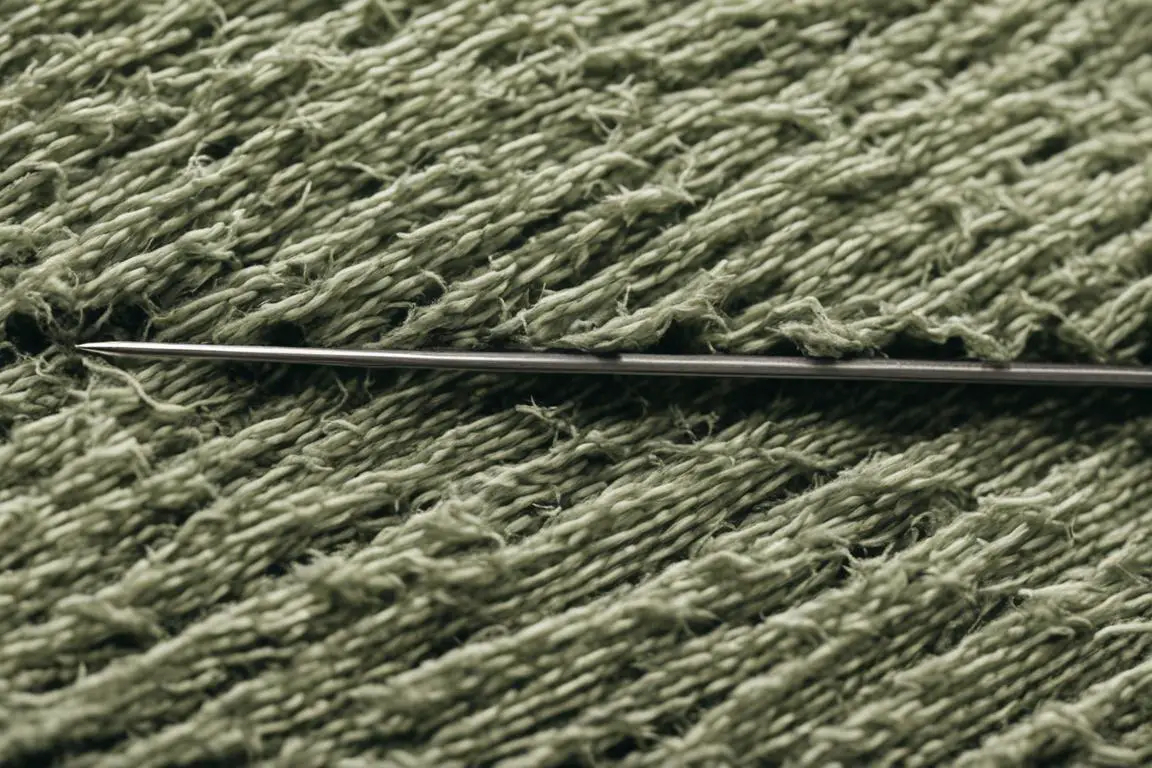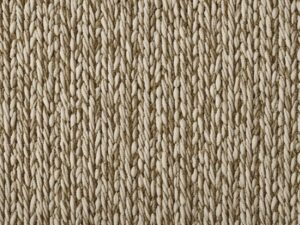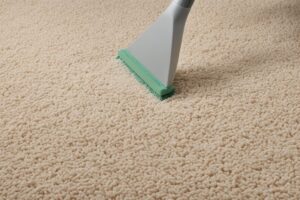Carpets are a significant investment in your home, so it can be frustrating when they start to fray or get damaged. However, you don’t necessarily have to replace the entire carpet or call in a professional to fix these issues. With some simple techniques and tools, you can easily repair fraying carpet on your own. In this guide, we will walk you through the process of fixing three common carpet problems: small damaged spots, wet carpet from leaks or flooding, and pulled-out carpet from a metal threshold. By following these easy steps, you can save money and extend the life of your carpet.
Key Takeaways:
- Repairing fraying carpet can save you money and extend the life of your carpet.
- You can easily patch small damaged spots on your carpet using simple tools like a carpet knife and tape.
- If your carpet gets wet, it’s important to dry it out quickly and replace the damaged pad if necessary.
- For pulled-out carpet from a metal threshold, you can reattach it using a knee kicker and a stiff putty knife.
- To prevent fraying carpet edges, use preventive measures like pet-proofing and regular carpet maintenance.
How to Patch a Damaged Spot on Your Carpet
If you have a small hole, tear, or burn on your carpet, you can easily patch it up to make the repair virtually invisible. Follow these simple steps:
- Start by using a carpet knife to cut out the damaged area. Make sure to cut through the carpet backing without damaging the surrounding fibers.
- Test-fit the replacement piece of carpet tape before sticking it in place permanently. This will ensure a proper fit.
- Peel off the tape’s backing and set each piece in place, making sure to align them properly.
- Place the patch tightly against one side of the hole and lower the other edges into place, pressing the patch into the tape with your fingers or a carpet tractor.
- Trim any fibers sticking up and let the repair set overnight. This will allow the patch to adhere firmly to the tape.
This technique works best for flat-surface carpets without patterns. However, it can also be used for carpets with color patterns or textured surfaces, although the repair may be slightly visible.
| Tools Needed: | Materials Needed: |
|---|---|
|
|
How to Rescue Wet Carpet from Leaks or Flooding
When your carpet gets wet from leaks or flooding, it’s important to act quickly to prevent further damage. Here’s a step-by-step guide to help you rescue your wet carpet and minimize water damage:
1. Dry out the wet carpet
To begin the drying process, use fans to increase air circulation and speed up evaporation. It’s crucial to remove as much moisture as possible to prevent mold and mildew growth. Additionally, carefully fold back the wet carpet to expose the affected area and promote airflow.
2. Replace the damaged carpet pad
If the wet area is relatively small, you may be able to salvage the carpet by replacing only the damaged pad. Start by cutting around the soaked section of the pad and carefully remove it. Measure the area that needs replacement and find a similar pad at a local flooring store or home center.
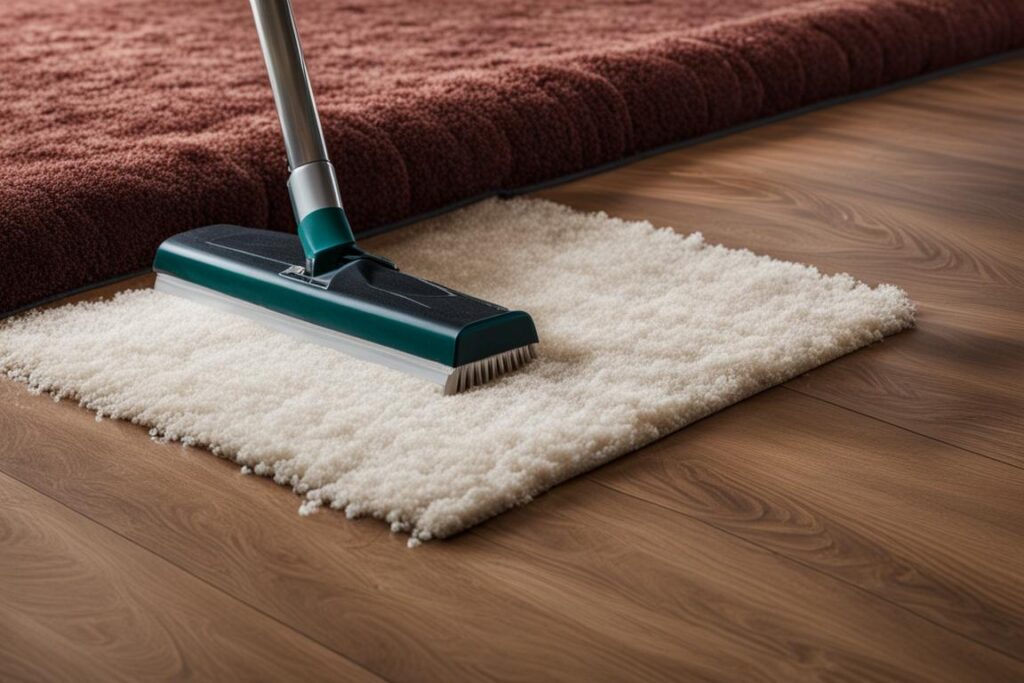
3. Install the new carpet pad
Lay the new pad in place, ensuring it aligns properly with the existing pad and covers the entire affected area. To secure the pad, use duct tape to join the seams where the new pad meets the old one. Fasten the pad to the floor using adhesive or staples, depending on the type of subfloor you have.
4. Reattach the carpet to the threshold
Once the new pad is in place, it’s time to reattach the carpet to the threshold. Use a knee kicker—an essential tool for carpet stretching—to stretch the carpet towards the threshold. With a putty knife, force the carpet into the teeth of the threshold, ensuring a secure attachment.
5. Re-stretch the carpet if necessary
If the carpet has stretched out of shape due to the moisture, you may need to use a power stretcher to restore its original tautness. This tool applies controlled tension to the carpet, eliminating wrinkles and ensuring a smooth and even surface.
6. Allow the carpet to dry completely
Before using the carpet again, make sure it is completely dry. Moisture trapped in the carpet fibers can lead to lingering odors and potential mold growth. Use a moisture meter to test the carpet’s moisture levels, ensuring they are within an acceptable range before resuming normal use.
By following these steps, you can successfully rescue your wet carpet from leaks or flooding and restore its functionality and appearance.
How to Reattach Pulled-Out Carpet from a Metal Threshold
If your carpet has been pulled out of a metal threshold, it’s crucial to reattach it correctly to prevent further damage and tripping hazards. Follow these steps to secure your carpet back in place:
- Release the carpet from the threshold: Begin by bending open the lip of the metal threshold using a screwdriver. This will help release the carpet.
- Remove the threshold: Once the carpet is released, pull out the nails and remove the metal threshold. Work from the carpeted side to avoid scratching the hard flooring.
- Kick the carpet tight towards the threshold: Use a knee kicker tool to kick the carpet tightly towards the threshold. This will help create tension and prevent any sagging.
- Force the carpet into the threshold: Using a stiff putty knife, force the carpet into the teeth of the metal threshold. This will ensure a secure and snug fit.
- Lock the carpet down: Drive down the lip of the threshold using taps back and forth along its length. This will securely lock the carpet in place.
By following these steps, you can effectively reattach your pulled-out carpet and avoid any further issues. Take the time to ensure a proper fit and alignment, as this will prevent tripping hazards and prolong the life of your carpet.
Prevention Tips for Fraying Carpet Edges
To prevent your carpet edges from fraying in the first place, there are a few things you can do. Follow these simple tips to ensure the longevity of your carpet and maintain its pristine condition.
Pet-Proofing Your Carpet
If you have pets, it’s essential to take measures to protect your carpet from their playful antics. Use pet repellent sprays or double-sided heavy-duty tape to deter them from scratching or pulling on the carpet edges. These products create a barrier that discourages pets from engaging in destructive behavior. By safeguarding your carpet from pet-related damage, you can prevent fraying and extend its lifespan.
Proper Carpet Installation
The way your carpet is installed plays a crucial role in preventing fraying and maintaining its overall condition. Ensure that your carpet is professionally installed, with the edges securely tacked down to the threshold. This will prevent the carpet from shifting or buckling, reducing the risk of fraying along the edges. Proper installation not only enhances the appearance of your carpet but also minimizes the likelihood of damage.
Regular Carpet Maintenance
Maintaining a regular cleaning and maintenance routine is essential for preventing fraying carpet edges. Vacuum your carpet regularly to remove dirt, debris, and loose fibers that can accumulate and contribute to wear and tear. Additionally, schedule professional carpet cleaning at least once a year to deep clean and refresh your carpet. Be sure to follow manufacturer recommendations for cleaning methods and products to prevent any potential damage.
Allowing Proper Drying
After cleaning your carpet, it’s important to allow it to dry properly to prevent moisture-related issues that can lead to fraying and damage. Ensure good ventilation in the room to promote air circulation and speed up drying. Avoid walking on wet carpet to prevent further damage and allow sufficient time for it to dry completely before resuming regular use.
Moving Furniture Periodically
Another preventive measure is to periodically move furniture in high-traffic areas or places prone to excessive wear. This allows the carpet to breathe and prevents uneven wear patterns and fraying. By redistributing the weight and pressure on different areas of the carpet, you can extend its lifespan and maintain its original condition.
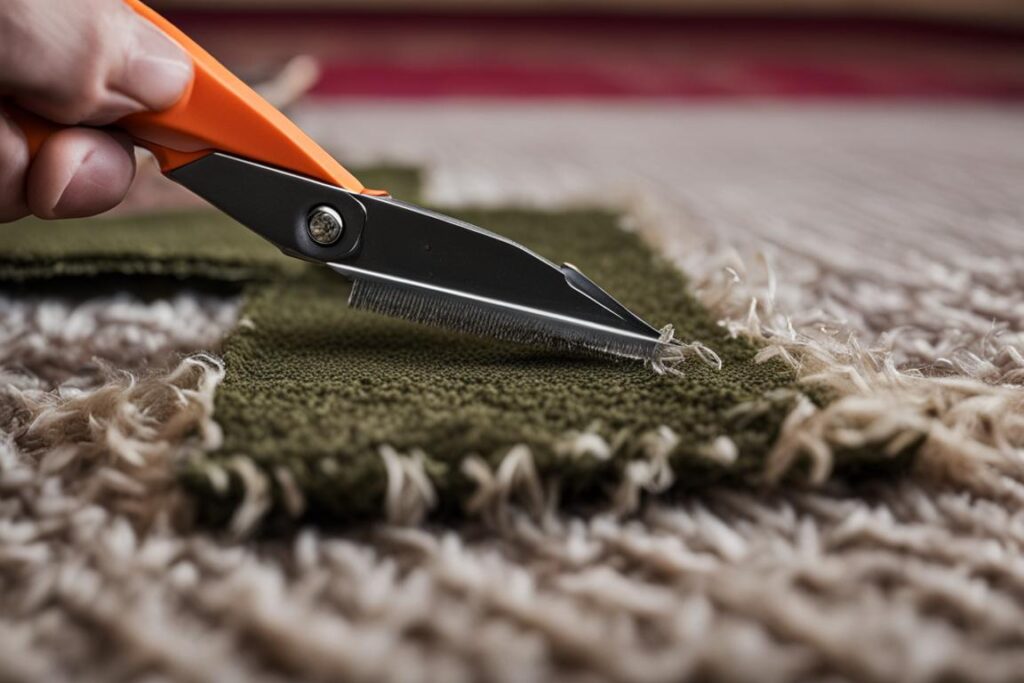
Making the Right Choice: Replace or Repair
When faced with fraying carpet or other damage, it’s important to consider whether to replace or repair the carpet. Repairs can be a cost-effective solution, especially for minor damage, and can extend the lifespan of your carpet. However, if the damage is extensive or the carpet is reaching the end of its lifespan, it may be more economical to replace the carpet altogether.
To make the right choice, evaluate the extent of the damage, the overall condition of the carpet, and your budget. If the damage is minimal and localized, such as small tears or burns, patching or reweaving might be the best option. This can be done using carpet tapes or contacting a professional carpet repair service.
On the other hand, if the carpet is significantly damaged, with large areas of fraying, extensive staining, or wear and tear throughout, replacing the carpet may be a more practical solution. Additionally, if the carpet is old and worn out, replacing it with a new one can provide a fresh look and better longevity.
A professional carpet repair service can provide expert advice and help you make an informed decision based on their assessment of your carpet’s condition and the estimated cost of repairs versus replacement.
Consider the following factors when making your decision:
- The extent and nature of the damage
- The overall condition and age of the carpet
- Your budget for repairs or replacement
- Long-term goals for your home or space
Ultimately, the choice between repairing or replacing your carpet depends on the specific circumstances of your situation. Both options have their advantages, so carefully weigh the pros and cons before making a decision.
Remember, regular maintenance and care can help extend the lifespan of your carpet, reducing the need for frequent repairs or premature replacement. Keep in mind that professional carpet cleaning, periodic vacuuming, and proactive measures to prevent damage can significantly prolong the life of your carpet.
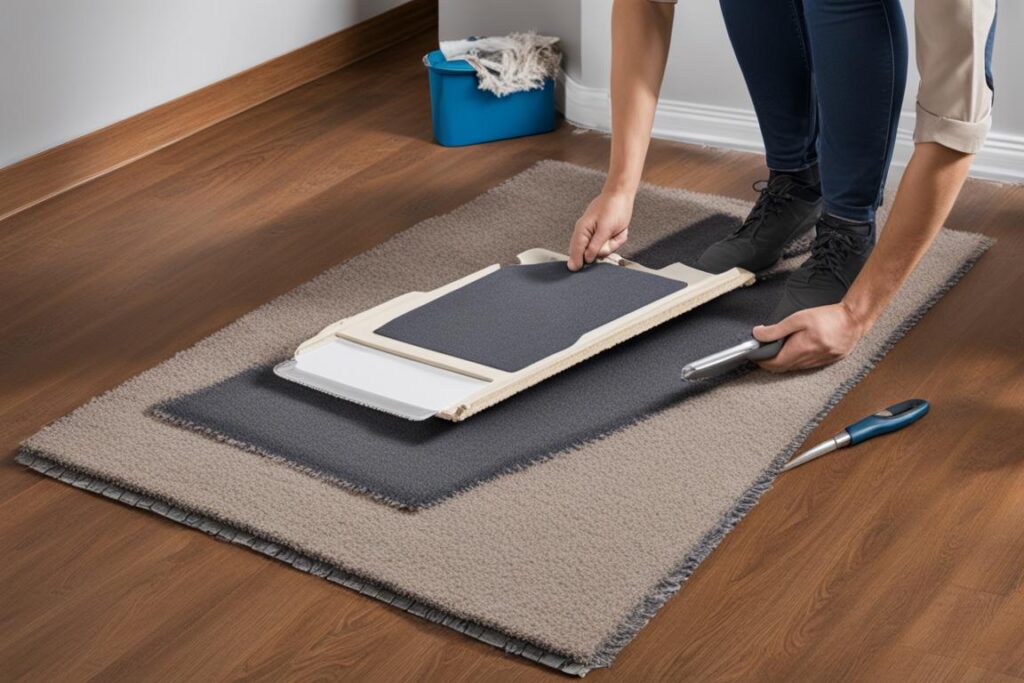
“Quality carpets are a long-lasting investment in your home, so it’s essential to make the right decision when it comes to repairing or replacing them.”
Conclusion
Repairing fraying carpet doesn’t have to be a daunting task. With the right tools and techniques, you can easily fix small damaged spots, rescue wet carpet, and reattach pulled-out carpet to a metal threshold. By following the repair steps outlined in this guide, you can save money and extend the life of your carpet.
Remember to take preventive measures to avoid fraying carpet edges, such as pet-proofing and regular carpet maintenance. By using pet repellent sprays or double-sided heavy-duty tape, you can protect your carpet from pets pulling on the edges. Proper installation and regular cleaning will also help maintain the carpet’s integrity and prevent wear and tear.
When faced with the decision to repair or replace your carpet, consider factors like the extent of damage, overall condition, and budget. Repairs can be a cost-effective solution and can significantly extend the lifespan of your carpet. However, if the damage is extensive or your carpet is nearing the end of its lifespan, replacing it may be a more practical choice. Consulting with a professional carpet repair service can provide valuable insights to help you make the right decision.
By following these DIY carpet repair tips and taking preventive measures, you can keep your carpet looking great and enjoy its comfort and beauty for years to come.
FAQ
How can I patch a damaged spot on my carpet?
To patch a damaged spot on your carpet, start by using a carpet knife to cut out the damaged area. Then, test-fit the replacement piece of carpet tape before sticking it in place permanently. Finally, trim any fibers sticking up and let the repair set overnight.
What should I do if my carpet gets wet from leaks or flooding?
If your carpet gets wet from leaks or flooding, start by drying out the wet carpet using fans and folding back the carpet. Cut around the soaked section of pad and remove it. You can save the carpet by replacing the damaged pad and reattaching it to the new threshold.
How can I reattach pulled-out carpet from a metal threshold?
To reattach pulled-out carpet from a metal threshold, release the carpet from the threshold by bending open its lip using a screwdriver. Pull out the nails and remove the threshold. Kick the carpet tight towards the threshold using a knee kicker and force the carpet into the threshold teeth with a stiff putty knife. Finally, lock the carpet down by driving down the lip of the threshold.
How can I prevent fraying carpet edges?
To prevent fraying carpet edges, use pet repellent sprays or double-sided heavy-duty tape to prevent pets from pulling on the carpet edges. Make sure your carpet is properly installed with the edges securely tacked down to the threshold. Regularly vacuum and clean your carpet to remove dirt and debris that can cause wear and tear.
Should I replace or repair my carpet?
When deciding whether to replace or repair your carpet, evaluate the extent of the damage, the overall condition of the carpet, and your budget. Repairs can be a cost-effective solution, especially for minor damage, and can extend the life of your carpet. However, if the damage is extensive or the carpet is reaching the end of its lifespan, it may be more economical to replace the carpet altogether. Consulting with a professional carpet repair service can also help you make an informed decision.
